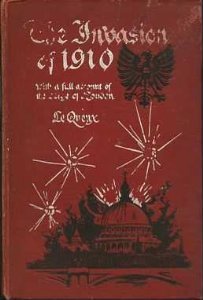|
I was just casually reading through Votes for Women from 23rd January 1914 when this leapt out at me and made me giggle: 'The sleepiest of Norfolk villages was lately roused up by the visit of a theatrical party who had come to rehearse "The Invasion of England" for a cinematograph representation. For a whole day wild men from across the sea, in appropriate costume and lurid make-up, struggled savagely with peaceful Britons. The High Street was a scene of pillage and violence while the film man quietly took his snapshots for the benefit of London. An aged lady of the neighbourhood, driving in her carriage through the village, seeing what appeared to be the innkeeper dragged from his threshold to be murdered in the roadway, while, amidst arrows and stones other men throttled and yelled, drew up in alarm. For a moment she looked terrified. Then all for a sudden her face cleared, and she nodded her head. "Ah, the Suffragettes, I suppose! Drive on, John."' Reading this gem I couldn't help but be curious! A little research revealed that the filming was for If England were Invaded, made in 1913 by Gaumont. The film was based on a novel, The Invasion of 1910, by William le Queux, and is set in Norfolk. Initially titled The Raid of 1915, the release of the film was delayed by the British Board of Film Censors. Some of the information available suggests that it was considered too politically sensitive, given the global situation. You can read the novel for free on Project Gutenberg. Le Queux, a journalist and prolific writer, published the The Invasion of 1910 in 1906. An account of a fictionalised military history in which Germany invades Britain, it was serialised in the Daily Mail and became incredibly popular, with over a million books sold. It was also translated into twenty-seven languages. Seen as anti-German, the novel warned the British Government of the threat from Germany - and as it turns out the film was released on 19th October 1914, three months after the start of the First World War. Le Queux himself became worried at the start of the war that the Germans were going to target him personally and he continued to write anti-German and anti-Russian fiction presented as fact throughout the war. His memoir, Things I Know about Kings, Celebrities and Crooks, was published in 1923 and is described in his ODNB entry as unreliable and largely fictitious. If England were Invaded was directed by Fred W Durrant,
who three years later in 1917 directed a film adaptation of J.M. Barrie's 1908 play What Every Woman Knows with Actresses' Franchise League member Hilda Trevelyan in the cast. Trevelyan had been in original production of the play alongside other AFL members and supporters including Gerald du Maurier and Lillah McCarthy. It had a long and succesful run in the West End, first at the Duke of York's Theatre and then at the Hicks Theatre (now the Gielgud) The play is considered to be a suffrage play by many scholars and was popular among suffragists - AFL member May Whitty attended a performance at the Duke of York's Theatre on 2nd March 1909. Hilda Trevelyan had also been in the original cast of Barrie's play Peter Pan at the Duke of York's Theatre in 1904, creating the role of Wendy opposite another future Actreses' Franchise League member, Nina Boucicault, who played Peter. Durrant was the first to make a film of What Every Woman Knows - there was another silent version in 1921 produced by Paramount and directed by William C. de Mille, and a 1934 MGM version directed by Gregory La Cava. You can read the play for free on Project Gutenberg. I haven't been able to find any images of The Invasion of England - but should you wish to see some stills there are some in the 1st October 1914 issue of The Bioscope (available on microfilm at the BFI) - and a review of the film in the same journal a week later. I hope the reviewer didn't mistake the advancing German troops for militant Suffragettes!
0 Comments
Leave a Reply. |
NaomiThoughts, reflections, bits of research Archives
April 2023
Categories
All
|

 RSS Feed
RSS Feed